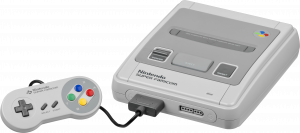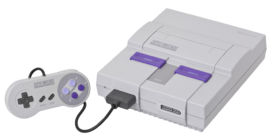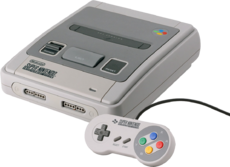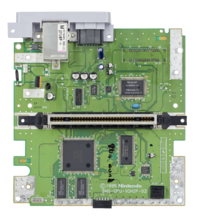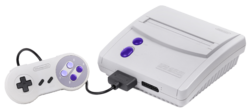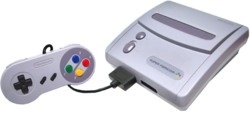SNES:Buying Guide: Difference between revisions
No edit summary |
|||
| Line 37: | Line 37: | ||
|| (image needed) || SHVC-CPU-01 || 1990-1992 || NTSC || Has a removable cartridge port and a separate module which contains the sound hardware. Is physically larger than all other board revisions. '''Highly susceptible to chip failure and leaky capacitors (see section below).''' | || (image needed) || SHVC-CPU-01 || 1990-1992 || NTSC || Has a removable cartridge port and a separate module which contains the sound hardware. Is physically larger than all other board revisions. '''Highly susceptible to chip failure and leaky capacitors (see section below).''' | ||
|- | |- | ||
|| (image needed) || SNS-CPU-GPM-01/02 || 1992-1994 || NTSC || Incorporates the sound hardware onto the motherboard. Video quality is slightly worse than the SHVC-CPU-01. Cartridge port is still removable. | || (image needed) || SNS-CPU-GPM-01/02 || 1992-1994 || NTSC || Incorporates the sound hardware onto the motherboard. Video quality is slightly worse than the SHVC-CPU-01. Cartridge port is still removable on most boards, but later GPM-02s have a soldered cartridge port. | ||
|- | |- | ||
|| (image needed) || SNSP-CPU-01/02 || 1992-1995 || PAL || Similar to the GPM-01/02, but adds a circuit which generates 12V DC for SCART autoswitching. | || (image needed) || SNSP-CPU-01/02 || 1992-1995 || PAL || Similar to the GPM-01/02, but adds a circuit which generates 12V DC for SCART autoswitching. | ||
Revision as of 19:03, 13 February 2024
There are two major variants of the SNES and Super Famicom, with the original model having a number of different revisions. This buying guide serves to delineate the differences between these revisions and briefly explain what to look for when adding an SNES or Super Famicom to your setup.
Original Model (SNS-001/SNSP-001/SHVC-001)
- Released in the following regions:
- Japan: November 1990
- North America: August 1991
- PAL regions: 1992
- South Korea: 1992
- Brazil: August 1993
- Has two major cosmetic designs, a rounded one which was used in Japan, Korea and PAL territories, and a more rectangular design used in North America and Brazil. The cartridge shapes also differ between regions and are not interchangeable without adapters or modding
- Outputs composite video, S-video, RGB and stereo audio from a custom 12-pin multiout connector
- All except French models also have RF output
- The power input jack differs between regions:
- Super Famicom consoles take a 5.5 x 2.1 mm barrel jack with tip negative polarity, power supply specifications are the same as the original Famicom (9V DC, 850 mA)
- US SNES consoles take a 6.9 x 4.1 mm barrel jack with a center pin and tip negative polarity. Specifications are 9V DC, 850 mA
- PAL SNES consoles take a 5.5 x 2.5 mm barrel jack, power supply specifications are the same as the PAL NES (9V AC, 1.3 A)
- Earlier US SNES consoles and all PAL and JP consoles have a cartridge lock mechanism designed to prevent cartridges being removed while the console is powered on
- Has an expansion port on the bottom which was largely unused. It was only used for the Satellaview accessory in Japan, and the extremely rare LifeCycle Exertainment exercise bike
- Older consoles are more susceptible to yellowing, which also causes the shell to become brittle. Newer consoles are more resistant but not immune to this. Replacement high quality shells are available from Retro Game Restore, but are rather costly and are only available in transparent colorways with a smooth finish.
- All model 1 consoles are identical in functionality, though the 1CHIP models have significantly sharper video quality and are much more desirable as a result. However, the 1CHIP models have some caveats, such as game compatibility problems and flaws with their video output. If these compatibility issues do not concern you, the 1CHIP models are an otherwise great choice and their video issues can be fixed, giving them excellent video quality.
- Older model 1s before the 1CHIP have fairly blurry RGB, but various mods exist (with another in development) which can resolve this problem. This issue is also less apparent through composite video and S-video. If you want to be able to play every game without problems, these revisions are the ones to go for. In addition, since they are far more common and in less demand than the 1CHIPs, they can be had for significantly less.
- Avoid the original SHVC-CPU-01 revision if possible. See the special section on these below for more information.
- The later SNS-CPU-APU-01 revision has poor RGB output, but can be fixed
Board Revisions
Nintendo produced several revisions of the model 1, with each revision consolidating chips and/or circuitry to reduce production costs. Brazilian, Japanese and North American models share the same motherboard revisions, while PAL models received their own.
A word about the SHVC-CPU-01
Consoles with an SHVC-CPU-01 board revision have serious longevity concerns, as an increasing number of these consoles are experiencing chip failures. These failures usually afflict the CPU and/or both PPUs, and manifest as issues such as corrupted graphics, booting only certain games, or controllers not working. In addition, these consoles are also beginning to suffer from leaky capacitors, which can cause various problems and can damage the board if not rectified in time. Because of these growing problems, consoles with an SHVC-CPU-01 board are not recommended, especially if they are being sold as "untested". Thankfully, these revisions are easily discerned by looking at the bottom of the console. If it has four rubber feet on the bottom, it will have an SHVC-CPU-01 board. All later board revisions only have two rubber feet at the front. If you do decide to purchase an SHVC-CPU-01 console, make absolutely sure it is fully tested and if possible, run the SNES Burn-In Test to ensure the console is actually functioning properly.
New-Style SNES/Super Famicom Jr.
- Only released in North America (October 1997), Japan (January 1998) and Brazil (1998)
- Complete redesign with a smaller case, no eject button and no expansion port
- Only outputs composite video via the same multiout connector as before; S-video and RGB outputs were removed and RF is only available with an external modulator
- S-video and RGB outputs can be restored by performing an RGB bypass mod or wiring the appropriate pins from the video encoder to the multiout
- Brazilian consoles only have RF out and lack the multiout
- Has only one board revision (SNN-CPU-01) which is heavily based on the 1CHIP revisions
- Because the SNS-101 uses the 1CHIP ASIC, it has all the same issues including the same compatibility problems.
- On the other hand, video output is just as crisp as the 1CHIP consoles
- Replacement cartridge trays are available for the SNS-101 so that Super Famicom games will fit; PAL games still require additional modding
- The Super Famicom Jr. has a cartridge slot which only fits Japanese games
- Despite its missing features, the SNS-101 is a good choice as it has the sharp video output of the 1CHIP consoles but in a smaller package. It also tends to be less expensive than the 1CHIP models since it only has composite video in stock form. RGB and S-video outputs can be easily restored, and once these mods are performed it is essentially on par with an original 1CHIP model. However, it is harder to track down since it was released very late in the SNES's life and still has all the same aforementioned issues as the 1CHIP consoles.
